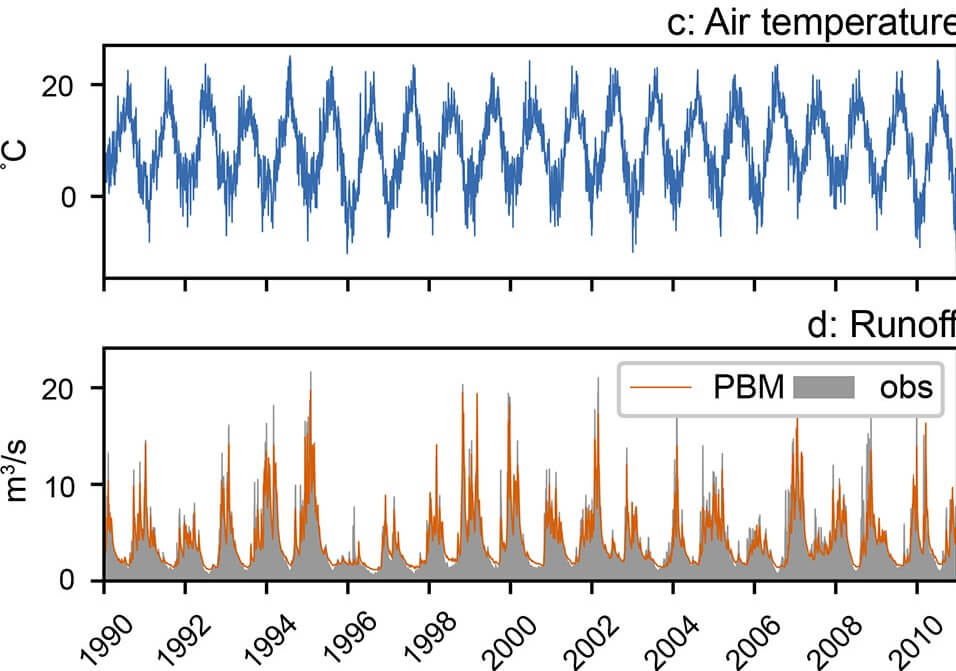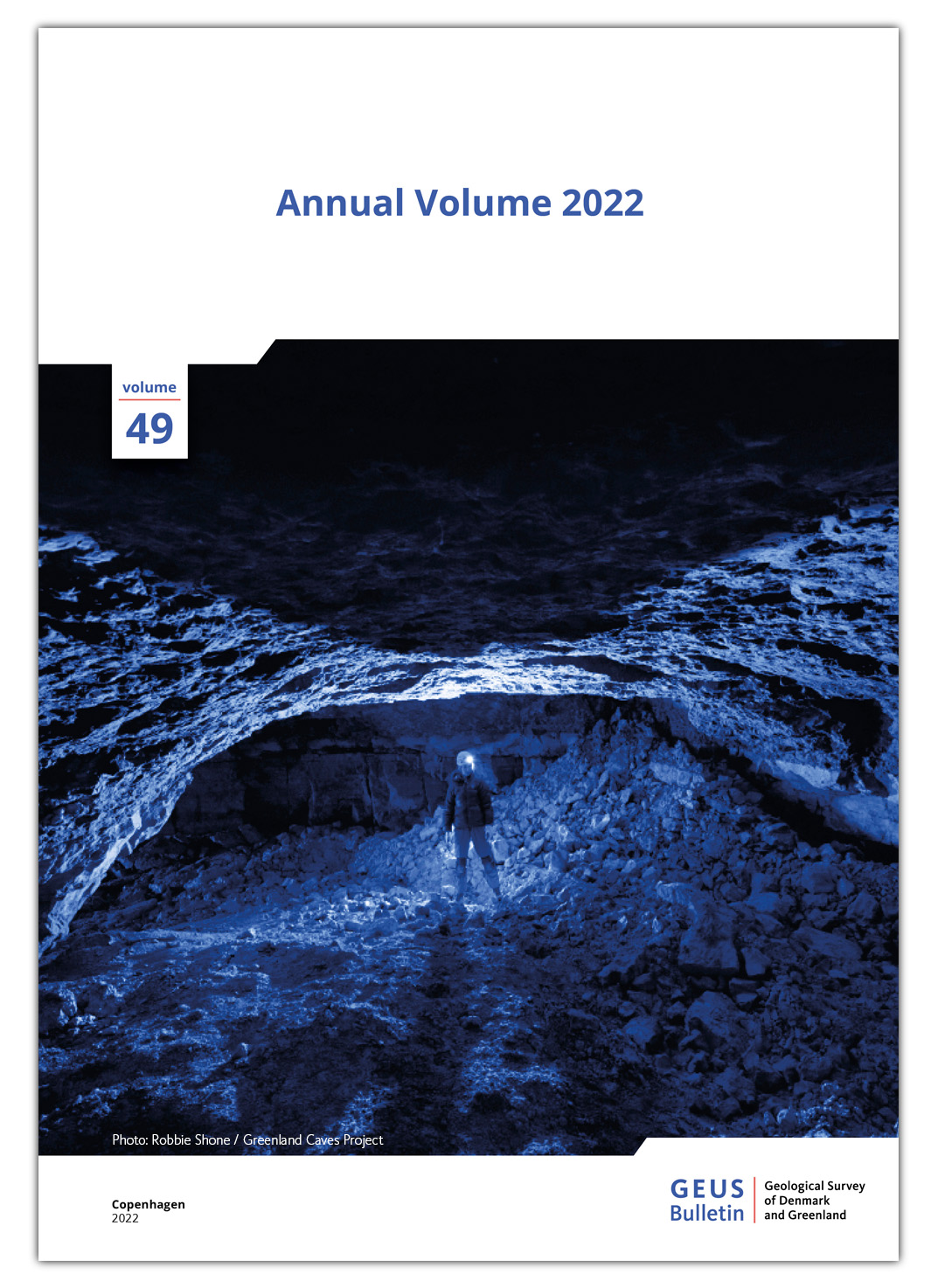
How to Cite
Share
Abstract
This study explores the application of long short-term memory (LSTM) networks to simulate runoff at the national scale of Denmark using data from 301 catchments. This is the first LSTM application on Danish data. The results were benchmarked against the Danish national water resources model (DK-model), a physically based hydrological model. The median Kling-Gupta Efficiency (KGE), a common metric to assess performance of runoff predictions (optimum of 1), increased from 0.7 (DK-model) to 0.8 (LSTM) when trained against all catchments. Overall, the LSTM outperformed the DK-model in 80% of catchments. Despite the compelling KGE evaluation, the water balance closure was modelled less accurately by the LSTM. The applicability of LSTM networks for modelling ungauged catchments was assessed via a spatial split-sample experiment. A 20% spatial hold-out showed poorer performance of the LSTM with respect to the DK model. However, after pre-training, that is, weight initialisation obtained from training against simulated data from the DK-model, the performance of the LSTM was effectively improved. This formed a convincing argument supporting the knowledge-guided machine learning (ML) paradigm to integrate physically based models and ML to train robust models that generalise well.
How to Cite
Share
Copyright (c) 2022 Julian Koch, Raphael Schneider

This work is licensed under a Creative Commons Attribution 4.0 International License.
Supplementary Files
Funding
None provided.Downloads
An annual collection of articles submitted to GEUS Bulletin, published throughout 2022.
Cover photo: Gina Moseley explores a cave in North-East Greenland. Credit: Robbie Shone / Greenland Caves Project. Read more in Smith, P. & Moseley, G. 2022: The karst and palaeokarst of North and North-East Greenland – physical records of [...]
References
-
Addor, N., Newman, A.J., Mizukami, N. & Clark, M.P. 2017: The CAMELS data set: Catchment attributes and meteorology for large-sample studies. Hydrology and Earth System Sciences 21, 5293–5313. https://doi.org/10.5194/hess-21-5293-2017
-
Gauch, M., Mai, J. & Lin, J. 2021: The proper care and feeding of CAMELS: How limited training data affects streamflow prediction. Environmental Modelling and Software 135, 104926. https://doi.org/10.1016/j.envsoft.2020.104926
-
Gupta, H.V, Kling, H., Yilmaz, K.K. & Martinez, G.F. 2009: Decomposition of the mean squared error and NSE performance criteria: Implications for improving hydrological modelling. Journal of Hydrology 377(1–2), 80–91. https://doi.org/10.1016/j.jhydrol.2009.08.003
-
Henriksen, H.J., Troldborg, L., Nyegaard, P., Sonnenborg, T.O., Refsgaard, J.C. & Madsen, B. 2003: Methodology for construction, calibration and validation of a national hydrological model for Denmark. Journal of Hydrology 280, 52–71. https://doi.org/10.1016/S0022-1694(03)00186-0
-
Hochreiter, S. & Schmidhuber, J. 1997: Long Short-Term Memory. Neural Computation 9, 1735–1780. https://doi.org/10.1162/neco.1997.9.8.1735
-
Hoedt, P.-J., Kratzert, F., Klotz, D., Halmich, C., Holzleitner, M., Nearing, G., Hochreiter, S. & Klambauer, G. 2021: MC-LSTM: Mass-Conserving LSTM. arXiv preprint arXiv:2101.05186 (2021).
-
Højberg, A.L., Troldborg, L., Stisen, S., Christensen, B.B.S. & Henriksen, H.J. 2013: Stakeholder driven update and improvement of a national water resources model. Environmental Modelling and Software 40, 202–213. https://doi.org/10.1016/j.envsoft.2012.09.010
-
Jia, X. et al. 2021: Physics-guided recurrent graph model for predicting flow and temperature in river networks. In: Demeniconi, C. & Davidson, I. (eds): Proceedings of the 2021 SIAM International Conference on Data Mining (SDM), Virtual conference, 612–620. https://doi.org/10.1137/1.9781611976700.69
-
Kratzert, F., Klotz, D., Brenner, C., Schulz, K. & Herrnegger, M. 2018: Rainfall-runoff modelling using Long Short-Term Memory (LSTM) networks. Hydrology and Earth System Sciences 22, 6005–6022. https://doi.org/10.5194/hess-22-6005-2018
-
Kratzert, F., Klotz, D., Herrnegger, M., Sampson, A.K., Hochreiter, S. & Nearing, G.S. 2019a: Toward improved predictions in ungauged basins: Exploiting the power of machine learning. Water Resources Research 55, 11344–11354. https://doi.org/10.1029/2019WR026065
-
Kratzert, F., Klotz, D., Shalev, G., Klambauer, G., Hochreiter, S. & Nearing, G. 2019b: Towards learning universal, regional, and local hydrological behaviors via machine learning applied to large-sample datasets. Hydrology and Earth System Sciences 23, 5089–5110. https://doi.org/10.5194/hess-23-5089-2019
-
Ma, K. et al. 2021: Transferring hydrologic data across continents – Leveraging data-rich regions to improve hydrologic prediction in data-sparse regions. Water Resources Research 57, e2020WR028600. https://doi.org/10.1029/2020WR028600
-
Mai, J. et al. 2021: Great lakes runoff intercomparison project phase 3: Lake Erie (GRIP-E). Journal of Hydrologic Engineering 26, 1–19. https://doi.org/10.1061/(asce)he.1943-5584.0002097
-
Nearing, G.S., Kratzert, F., Sampson, A.K., Pelissier, C.S., Klotz, D., Frame, J.M., Prieto, C. & Gupta, H.V. 2020: What role does hydrological science play in the age of machine learning? Water Resources Research 57, e2020WR028091. https://doi.org/10.1029/2020wr028091
-
Ouyang, W., Lawson, K., Feng, D., Ye, L., Zhang, C. & Shen, C. 2021: Continental-scale streamflow modeling of basins with reservoirs: Towards a coherent deep-learning-based strategy. Journal of Hydrology 599, 126455. https://doi.org/10.1016/j.jhydrol.2021.126455
-
Read, J.S. et al. 2019: Process-guided deep learning predictions of lake water temperature. Water Resources Research 55, 9173–9190. https://doi.org/10.1029/2019WR024922
-
Reichstein, M., Camps-Valls, G., Stevens, B., Jung, M., Denzler, J., Carvalhais, N. & Prabhat 2019: Deep learning and process understanding for data-driven Earth system science. Nature 566(7743), 195–204. https://doi.org/10.1038/s41586-019-0912-1
-
Scharling, M. 1999a: Klimagrid Danmark: Nedbør, lufttemperatur og potentiel fordampning 20*20 & 40*40 km. Danish Meteorological Institute Technical Report 99-12, DMI, Copenhagen, DK.
-
Scharling, M. 1999b: Klimagrid Danmark: Nedbør 10*10 km (ver. 2). Danish Meteorological Institute Technical Report 99-15, DMI, Copenhagen, DK.
-
Shen, C. 2018: A trans-disciplinary review of deep learning research and its relevance for water resources scientists. Water Resources Research 54, 8558–8593. https://doi.org/10.1029/2018WR022643
-
Stisen, S., Ondracek, M., Troldborg, L., Schneider, R.J.M. & van Thil, M.J. 2019: National vandressource model. Modelopstilling og kalibrering af DK-model 2019. Danmarks og Grønlands Geologiske Undersøgelse Rapport 2019/31, GEUS, Copenhagen, DK.
-
Wagener, T., Wheater, H.S. & Gupta, H.V. 2004: Rainfall-runoff modelling in gauged and ungauged catchments, 332 pp. London: Imperial College Press. https://doi.org/10.1142/p335









